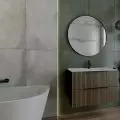On the one hand, great history and heritage, and on the other - a place for smart fun and recreation. A friendly space for nature education - in close symbiosis with the river and with a view of the cathedral - has been created at Poznań Gate.
The distinctive concrete cube of Poznań Gate (designed by Ad Artis Architects) has been giving character to the riverside outskirts of Śródka - a historic mini-district near Ostrów Tumski and the cathedral - for ten years now. However, the construction of the Gate, which is part of the Poznań Heritage Center (PCD), was not the end of the changes to this space.
Poznań Gate and the EcoEducation Garden visible on the riverbank, Poznań, view from Jordan Bridge - design: Nieplac Zabaw (formerly: k. studio).
photo: Jakub Głaz
A project conceived by PCD and coordinated by the City called "Gateway Open to the River" has been underway for several years . Because, in addition to activities related to the city's centuries-old heritage and its origins, the facility also deals with the broader story of the river in the city and adjacent areas (for example, through the Living River series).
The River Garden of EcoEducation, view from under the overhang of the Poznań Gate - proj.: Nieplac Zabaw (formerly: Studio k.)
photo: Jakub Głaz
multisensory, for all ages
Two elements were created as part of the project a year ago. The first is an Ecological Education Path along the Cybina and Warta River between the Poznań Gate and the Lech Bridge, two kilometers away. The second component is the Experimental Heritage Garden (EOD) right next to the Gate, on the short stretch between it and the Jordan Bridge leading from Ostrów Tumski to Śródka.
Experimental Heritage Garden at Ostrówek Street and Poznań Gate, view of Jordan Bridge and the Cathedral
photo: Jakub Głaz
This Monday, meanwhile, the River EcoEducation Garden was opened - in two locations: next to the EOD and below the Poznań Gate, on the floodplain of the Cybina River by the Wartostrada, a pedestrian and bicycle route created in the last decade on both sides of the Warta River. Poznań 's official website reads:
The Garden is a place where you can spend time experiencing various relationships and phenomena in the ecosystem through the use of educational stations. [...] The Eco-Education Garden can be used by both young children, who will explore it through multiple senses, and older children, for whom it will be a pretext for environmental education. This space also includes stations for workshops and rest areas that will be used regardless of age.
The River Garden of EcoEducation, view through part of the garden in the floodplain of the Cybina River over the built-up footbridge of the Poznań Gate and the cathedral, Poznań - design: Nieplac Zabaw (formerly: Studio k.).
photo: Jakub Głaz
nothing rubbery
The new garden is the final piece of the educational puzzle. It was designed by Nieplac Zabaw studio (formerly: pracownia k.), which specializes in this type of realizations. The name of the studio perfectly describes what the Poznan garden is not: a typical playground with lots of plastic, flashy colors and rubbery ground. All equipment, platforms, tables and seats are made primarily of wood and few steel elements. Their forms and function were developed after a workshop five years ago, in which children submitted their ideas. Some of the elements are permanently fixed to the ground, while others can be dismantled depending on the weather or the water level in the river.
The River Garden of EcoEducation, area at Ostrówek Street and Jordan Bridge, Poznań - designed by Nieplac Zabaw (formerly: Studio k.).
photo: Jakub Głaz
The River Garden of EcoEducation thus consists of (in addition to platforms, benches and tables with chess or Chinese boards): "mud kitchen," "garland,"" barefoot path," "water track," unusual slide, maze and balance beam. Some forms are obvious and can be immediately attributed to specific elements. The names of some sound a bit puzzling. Bartosz Małolepszy, PCD's deputy program director explains to us:
"A waterway is a kind of channel hollowed out of stone and polygonal wooden forms with troughs. With their use, one can observe the behavior of water, its force and action, just as it happens in a river, only that on a small scale. On the other hand, the "barefoot path" are boxes filled with pebbles, gravel, sand, cones, etc. You can see how to walk on such a natural surface. You can also just touch it. All devices are designed to affect multiple senses. This includes the "garland," or platform, around which various types of herbs have been planted for viewing, touching and smelling. Even the balance beam has its own hidden message - it allows one to realize how insecure animals feel crossing the ecological corridor by the river in the middle of the city.
River EcoEducation Garden, Poznań, "mud kitchen" and a newly landscaped section of the Cybina floodplain - proj.: Nieplac Zabaw (formerly: k. studio).
photo: Jakub Głaz
with a backpack to Lech
Malolepszy adds that in a few days , on the website of the "Gateway Open to the River" project, there will be presentations of each element with descriptions of its purpose and how they can be used in environmental education: individually, with the family, or in groups, during increasingly frequent school and kindergarten trips to the river.
River EcoEducation Garden, stone slide - proj.: Nieplac Zabaw (formerly: k. studio).
photo: Jakub Głaz
All of the equipment can therefore be experienced on your own or by taking advantage of workshops and events arranged by the Poznań Gate. This includes the Experimental Heritage Garden, which grows edible, dye, medicinal and honey plants - grown without fertilizer and watered with rainwater. Małolepszy reports:
Every month, we arrange duty hours in this garden, during which, under the guidance of our employee, you can work in the beds or - without any effort - learn more about the plants planted, ecology and the impact of climate change on crops. You can also borrow a backpack from us with a notebook and instruments for nature observation and set off along our ecological path towards the Lech Bridge.
Experimental Heritage Garden overlooking Ostrówek Street
photo: Jakub Głaz
This route, mentioned at the beginning of the text, runs along Wartostrada and leads through twelve marked points. Each is devoted to a different aspect related to the riverside ecosystem, for example: biodiversity, ecological corridor, anthropopression, history of the Cybina, etc.
River EcoEducation Garden, Ostrówek Street / Poznań Gate, Poznań - proj.: Nieplac Zabaw (formerly: k. studio).
photo: Jakub Głaz
The official opening of the new garden will take place next week, but it is already being used by curious strollers. The simple structures, alluding to the streamlined form of the Poznań Gate, fill the space they occupy well - especially in the section near the bridge.
The River Garden of EcoEducation, behind it the Experimental Garden of Heritage and the exposed backs of the tenements of Ostrówek Street, view from the Cybina River - designed by: Nieplac Zabaw (formerly: k. studio).
photo: Jakub Głaz
Wooden forms and greenery here soften the impact of the not-so-aesthetically pleasing tenement outbuildings and courtyards exposed as a result of wartime destruction and subsequent building transformations. In place of the new gardens: the Experimental and EcoEducation, there was until a few years ago a smashed threshing floor. Now it is dominated by diverse greenery and unpretentious and useful small architecture. This is a successful, yet another installment of the return of urban life to the Warta River, where - in addition to the construction of the Poznań Gate and Wartostrada - new places for rest and recreation have been created (including a park in the old riverbed), the historic River Baths have been renovated and the previously concreted banks have been partially renaturalized.






































































